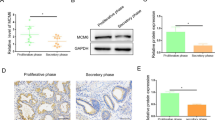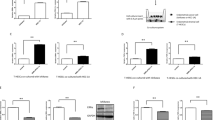Abstract
Estrogen (17β-oestradiol, E2) plays an essential role in endometrial receptivity and has been shown to stimulate angiogenesis via E2-ERα (estrogen receptor)-mediated upregulation of VEGF transcription. In this study, we have tried to decipher the mechanism of E2-promoting angiogenesis. We pre-incubated human endometrial microvascular endothelial cells (HEMECs) with E2 and performed western blotting, qRT-PCR, and cellular immunofluorescence experiments. We observed that E2 treatment of HEMECs increased ERα expression and reduced the expression of GRP78, which led to reduction of Caspase 3 expression by the CHOP pathway. In addition, E2 not only activated ERK signaling pathway but also inhibited p65 phosphorylation along with its translocation from nucleus to the cytoplasm, and subsequently inhibiting GRP78 expression, which led to inhibition of cell apoptosis. Together, these findings highlight the novel mechanism underlying E2-mediated improvement in endometrial angiogenesis through the ERK-p65 signaling pathway.







Similar content being viewed by others

Data Availability
The datasets used and/or analyzed during the current study are available from the corresponding authors on reasonable request.
References
van Mourik MS, Macklon NS, Heijnen CJ. Embryonic implantation: cytokines, adhesion molecules, and immune cells in establishing an implantation environment. J Leukoc Biol. 2009;85(1):4–19. https://doi.org/10.1189/jlb.0708395.
Haouzi D, Mahmoud K, Fourar M, Bendhaou K, Dechaud H, De Vos J, et al. Identification of new biomarkers of human endometrial receptivity in the natural cycle. Hum Reprod. 2009;24(1):198–205. https://doi.org/10.1093/humrep/den360.
Fan X, Krieg S, Kuo CJ, Wiegand SJ, Rabinovitch M, Druzin ML, et al. VEGF blockade inhibits angiogenesis and reepithelialization of endometrium. FASEB J. 2008;22(10):3571–80. https://doi.org/10.1096/fj.08-111401.
Smith SK. Angiogenesis and reproduction. BJOG. 2001;108(8):777–83. https://doi.org/10.1111/j.1471-0528.2001.00211.x.
Okada H, Tsuzuki T, Shindoh H, Nishigaki A, Yasuda K, Kanzaki H. Regulation of decidualization and angiogenesis in the human endometrium: mini review. J Obstet Gynaecol Res. 2014;40(5):1180–7. https://doi.org/10.1111/jog.12392.
Nayak NR, Brenner RM. Vascular proliferation and vascular endothelial growth factor expression in the rhesus macaque endometrium. J Clin Endocrinol Metab. 2002;87(4):1845–55. https://doi.org/10.1210/jcem.87.4.8413.
Buteau-Lozano H, Ancelin M, Lardeux B, Milanini J, Perrot-Applanat M. Transcriptional regulation of vascular endothelial growth factor by estradiol and tamoxifen in breast cancer cells: a complex interplay between estrogen receptors alpha and beta. Cancer Res. 2002;62(17):4977–84.
Iruela-Arispe ML, Rodriguez-Manzaneque JC, Abu-Jawdeh G. Endometrial endothelial cells express estrogen and progesterone receptors and exhibit a tissue specific response to angiogenic growth factors. Microcirculation. 1999;6(2):127–40.
Walter P, Ron D. The unfolded protein response: from stress pathway to homeostatic regulation. Science. 2011;334(6059):1081–6. https://doi.org/10.1126/science.1209038.
Guo YS, Sun Z, Ma J, Cui W, Gao B, Zhang HY, et al. 17Beta-estradiol inhibits ER stress-induced apoptosis through promotion of TFII-I-dependent Grp78 induction in osteoblasts. Lab Investig. 2014;94(8):906–16. https://doi.org/10.1038/labinvest.2014.63.
Kooptiwut S, Mahawong P, Hanchang W, Semprasert N, Kaewin S, Limjindaporn T, et al. Estrogen reduces endoplasmic reticulum stress to protect against glucotoxicity induced-pancreatic beta-cell death. J Steroid Biochem Mol Biol. 2014;139:25–32. https://doi.org/10.1016/j.jsbmb.2013.09.018.
Liaqat S, Hasnain S, Muzammil S, Hayat S. Polymorphism analysis in estrogen receptors alpha and beta genes and their association with infertile population in Pakistan. EXCLI J. 2015;14:1085–94. https://doi.org/10.17179/excli2015-559.
Gupta K, Sirohi VK, Kumari S, Shukla V, Manohar M, Popli P, et al. Sorcin is involved during embryo implantation via activating VEGF/PI3K/Akt pathway in mice. J Mol Endocrinol. 2018;60(2):119–32. https://doi.org/10.1530/JME-17-0153.
Madrid LV, Mayo MW, Reuther JY, Baldwin AS Jr. Akt stimulates the transactivation potential of the RelA/p65 subunit of NF-kappa B through utilization of the Ikappa B kinase and activation of the mitogen-activated protein kinase p38. J Biol Chem. 2001;276(22):18934–40. https://doi.org/10.1074/jbc.M101103200.
Bohuslav J, Chen LF, Kwon H, Mu Y, Greene WC. p53 induces NF-kappaB activation by an IkappaB kinase-independent mechanism involving phosphorylation of p65 by ribosomal S6 kinase 1. J Biol Chem. 2004;279(25):26115–25. https://doi.org/10.1074/jbc.M313509200.
Silva LA, Klein C, Ealy AD, Sharp DC. Conceptus-mediated endometrial vascular changes during early pregnancy in mares: an anatomic, histomorphometric, and vascular endothelial growth factor receptor system immunolocalization and gene expression study. Reproduction. 2011;142(4):593–603. https://doi.org/10.1530/REP-11-0149.
Danastas K, Whittington CM, Dowland SN, Combes V, Murphy CR, Lindsay LA. Ovarian hyperstimulation reduces vascular endothelial growth factor-A during uterine receptivity. Reprod Sci. 2019;26(2):259–68. https://doi.org/10.1177/1933719118768703.
Klauber N, Rohan RM, Flynn E, D'Amato RJ. Critical components of the female reproductive pathway are suppressed by the angiogenesis inhibitor AGM-1470. Nat Med. 1997;3(4):443–6. https://doi.org/10.1038/nm0497-443.
Walter LM, Rogers PA, Girling JE. Vascular endothelial growth factor-A isoform and (co) receptor expression are differentially regulated by 17beta-oestradiol in the ovariectomised mouse uterus. Reproduction. 2010;140(2):331–41. https://doi.org/10.1530/REP-10-0047.
Lessey BA, Killam AP, Metzger DA, Haney AF, Greene GL, McCarty KS Jr. Immunohistochemical analysis of human uterine estrogen and progesterone receptors throughout the menstrual cycle. J Clin Endocrinol Metab. 1988;67(2):334–40. https://doi.org/10.1210/jcem-67-2-334.
Xing D, Nozell S, Chen YF, Hage F, Oparil S. Estrogen and mechanisms of vascular protection. Arterioscler Thromb Vasc Biol. 2009;29(3):289–95. https://doi.org/10.1161/ATVBAHA.108.182279.
Selam B, Kayisli UA, Mulayim N, Arici A. Regulation of Fas ligand expression by estradiol and progesterone in human endometrium. Biol Reprod. 2001;65(4):979–85. https://doi.org/10.1095/biolreprod65.4.979.
Choi JY, Jo MW, Lee EY, Lee DY, Choi DS. Ovarian steroid dependence of endoplasmic reticulum stress involvement in endometrial cell apoptosis during the human endometrial cycle. Reproduction. 2018;155(6):493–503. https://doi.org/10.1530/REP-17-0713.
Sickinghe AA, Korporaal SJA, den Ruijter HM, Kessler EL. Estrogen contributions to microvascular dysfunction evolving to heart failure with preserved ejection fraction. Front Endocrinol (Lausanne). 2019;10:442. https://doi.org/10.3389/fendo.2019.00442.
Zhang F, Peng L, Huang Y, Lin X, Zhou L, Chen J. Chronic BDE-47 exposure aggravates malignant phenotypes and chemoresistance by activating ERK through ERalpha and GPR30 in endometrial carcinoma. Front Oncol. 2019;9:1079. https://doi.org/10.3389/fonc.2019.01079.
Dominguez R, Hu E, Zhou M, Baudry M. 17Beta-estradiol-mediated neuroprotection and ERK activation require a pertussis toxin-sensitive mechanism involving GRK2 and beta-arrestin-1. J Neurosci. 2009;29(13):4228–38. https://doi.org/10.1523/JNEUROSCI.0550-09.2009.
Jin X, Li Y, Guo Y, Jia Y, Qu H, Lu Y, et al. ERalpha is required for suppressing OCT4-induced proliferation of breast cancer cells via DNMT1/ISL1/ERK axis. Cell Prolif. 2019;52(4):e12612. https://doi.org/10.1111/cpr.12612.
Gonzalez-Ramos R, Rocco J, Rojas C, Sovino H, Poch A, Kohen P, et al. Physiologic activation of nuclear factor kappa-B in the endometrium during the menstrual cycle is altered in endometriosis patients. Fertil Steril. 2012;97(3):645–51. https://doi.org/10.1016/j.fertnstert.2011.12.006.
Galien R, Garcia T. Estrogen receptor impairs interleukin-6 expression by preventing protein binding on the NF-kappaB site. Nucleic Acids Res. 1997;25(12):2424–9. https://doi.org/10.1093/nar/25.12.2424.
Cerillo G, Rees A, Manchanda N, Reilly C, Brogan I, White A, et al. The oestrogen receptor regulates NFkappaB and AP-1 activity in a cell-specific manner. J Steroid Biochem Mol Biol. 1998;67(2):79–88. https://doi.org/10.1016/s0960-0760(98)00078-8.
Sun WH, Keller ET, Stebler BS, Ershler WB. Estrogen inhibits phorbol ester-induced I kappa B alpha transcription and protein degradation. Biochem Biophys Res Commun. 1998;244(3):691–5. https://doi.org/10.1006/bbrc.1998.8324.
Bozkurt M, Sahin L, Ulas M. Hysteroscopic polypectomy decreases NF-kappaB1 expression in the mid-secretory endometrium of women with endometrial polyp. Eur J Obstet Gynecol Reprod Biol. 2015;189:96–100. https://doi.org/10.1016/j.ejogrb.2015.03.032.
Code Availability
Not applicable.
Funding
The study was supported by the National Natural Science Foundation of China (No. 82074247, No. 81603654), the Department of Education of Hebei Province (No. ZD2018002, No. QN2019153), and the Foundation of Scientific Research Program of Hebei Administration of Traditional Chinese Medicine (No. 2018098).
Author information
Authors and Affiliations
Contributions
As the corresponding author, MH contributed to the statistical analysis and prepared the manuscript for writing, and XTW contributed to the conception and design of the study. YZ contributed to the statistical analysis. CC was responsible for the cell culture and treatment. SJD performed the western blot analysis and endothelial cell tube formation assay. LJF contributed to the isolation of mRNA and qRT-PCR. DZ performed the immunofluorescence staining.
Corresponding authors
Ethics declarations
Conflict of Interest
The authors declare that they have no conflict of interest.
Ethics Approval
Not applicable.
Consent to Participate
Not applicable.
Consent for Publication
Not applicable.
Additional information
Publisher’s Note
Springer Nature remains neutral with regard to jurisdictional claims in published maps and institutional affiliations.
Rights and permissions
About this article
Cite this article
Zhang, Y., Cao, C., Du, S. et al. Estrogen Regulates Endoplasmic Reticulum Stress–Mediated Apoptosis by ERK-p65 Pathway to Promote Endometrial Angiogenesis. Reprod. Sci. 28, 1216–1226 (2021). https://doi.org/10.1007/s43032-020-00414-0
Received:
Accepted:
Published:
Issue Date:
DOI: https://doi.org/10.1007/s43032-020-00414-0



